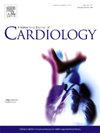Use of direct anticoagulants in chronic thromboembolic pulmonary hypertension: An anatomopathological study of endarterectomy material
IF 3.2
2区 医学
Q2 CARDIAC & CARDIOVASCULAR SYSTEMS
引用次数: 0
Abstract
Objetive
Chronic thromboembolic pulmonary hypertension (CTEPH) is a potentially curable cause of pulmonary hypertension, characterized by persistent organized thrombi and micro vasculopathy leading to increased pulmonary vascular resistance and right heart failure. Pulmonary endarterectomy (PEA) remains the treatment of choice for operable patients. Although vitamin K antagonists (VKAs) are traditionally used for lifelong anticoagulation, direct oral anticoagulants (DOACs) have gained popularity despite limited evidence supporting their use in CTEPH. Histopathological assessment may provide new insights into anticoagulation effectiveness. This study aimed to evaluate the presence of recent thrombi in PEA specimens from patients using DOACs versus VKAs and to correlate these findings with surgical and hemodynamic outcomes.
Methods
Retrospective cohort study included 115 patients with CTEPH who underwent PEA at a national referral center for the treatment of CTEPH between 2018 and 2023. Patients were categorized based on anticoagulant type (DOAC or VKA). All surgical specimens underwent histopathological evaluation. Pre- and postoperative hemodynamic and clinical data were analyzed. Statistical comparisons were performed using appropriate parametric and non-parametric tests.
Results
Recent thrombi were identified in 26.2 % of patients on DOACs and 9.2 % of those on VKAs (p < 0.05). Despite the higher prevalence of thrombi in the DOAC group, no significant differences were observed in extracorporeal circulation time, cardiac arrest duration, or postoperative hemodynamic parameters between groups. Microscopic evaluation proved to be more sensitive than macroscopic analysis for detecting thrombi.
Conclusion
Our findings demonstrate the presence of recent thrombi in patients with CTEPH undergoing PEA. This observation raises questions regarding the use of DOACs in patients with CTEPH.

使用直接抗凝剂治疗慢性血栓栓塞性肺动脉高压:动脉内膜切除术材料的解剖病理学研究。
目的:慢性血栓栓塞性肺动脉高压(CTEPH)是一种潜在的可治愈的肺动脉高压病因,其特征是持续的有组织血栓和微血管病变,导致肺血管阻力增加和右心衰。肺动脉内膜切除术(PEA)仍然是可手术患者的治疗选择。尽管维生素K拮抗剂(VKAs)传统上用于终身抗凝,但直接口服抗凝剂(DOACs)已越来越受欢迎,尽管支持其用于CTEPH的证据有限。组织病理学评估可能为抗凝效果提供新的见解。本研究旨在评估使用DOACs和vka的患者PEA标本中近期血栓的存在,并将这些发现与手术和血流动力学结果联系起来。方法:回顾性队列研究纳入了2018年至2023年间在国家转诊中心接受PEA治疗的115例CTEPH患者。根据抗凝类型(DOAC或VKA)对患者进行分类。所有手术标本均行组织病理学检查。分析术前、术后血流动力学及临床资料。采用适当的参数检验和非参数检验进行统计比较。结果:26.2% %的DOACs患者和9.2% %的VKAs患者发现近期血栓(p )结论:我们的研究结果表明,接受PEA治疗的CTEPH患者存在近期血栓。这一观察结果提出了关于在CTEPH患者中使用DOACs的问题。
本文章由计算机程序翻译,如有差异,请以英文原文为准。
求助全文
约1分钟内获得全文
求助全文
来源期刊

International journal of cardiology
医学-心血管系统
CiteScore
6.80
自引率
5.70%
发文量
758
审稿时长
44 days
期刊介绍:
The International Journal of Cardiology is devoted to cardiology in the broadest sense. Both basic research and clinical papers can be submitted. The journal serves the interest of both practicing clinicians and researchers.
In addition to original papers, we are launching a range of new manuscript types, including Consensus and Position Papers, Systematic Reviews, Meta-analyses, and Short communications. Case reports are no longer acceptable. Controversial techniques, issues on health policy and social medicine are discussed and serve as useful tools for encouraging debate.
 求助内容:
求助内容: 应助结果提醒方式:
应助结果提醒方式:


